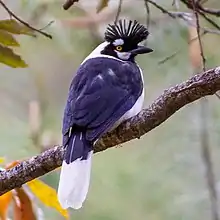Cyanocorax
Cyanocorax is a genus of New World jays, passerine birds in the family Corvidae. The generic name is derived from the Greek words κυανος (kuanos), meaning "dark blue," and κοραξ (korax), meaning "raven".[2][3]
| Cyanocorax | |
|---|---|
 | |
| Plush-crested jay, Cyanocorax chrysops | |
| Scientific classification | |
| Domain: | Eukaryota |
| Kingdom: | Animalia |
| Phylum: | Chordata |
| Clade: | Dinosauria |
| Class: | Aves |
| Order: | Passeriformes |
| Family: | Corvidae |
| Genus: | Cyanocorax F. Boie, 1826 |
| Type species | |
| Corvus pileatus[1] Temminck, 1821 | |
| Species | |
|
see text | |
It contains several closely related species that primarily are found in wooded habitats of Mexico and Central and South America, with the green jay just barely entering the United States.
The genus Cyanocorax was introduced by the German zoologist Friedrich Boie in 1826, with the plush-crested jay as the type species.[4][5]
Species
The genus contains 17 species:[6]
| Image | Scientific name | Common Name | Distribution |
|---|---|---|---|
 | Cyanocorax melanocyaneus | Bushy-crested jay | Guatemala, El Salvador, Honduras and Nicaragua |
 | Cyanocorax sanblasianus | San Blas jay | Mexico |
 | Cyanocorax yucatanicus | Yucatan jay | Yucatán Peninsula |
_(8079391927).jpg.webp) | Cyanocorax beecheii | Purplish-backed jay | northwestern Mexico |
.jpg.webp) | Cyanocorax violaceus | Violaceous jay | Bolivia, Brazil, Colombia, Ecuador, Guyana, Peru, and Venezuela |
 | Cyanocorax caeruleus | Azure jay | south-eastern Brazil (São Paulo to Rio Grande do Sul), far eastern Paraguay and far north-eastern Argentina |
 | Cyanocorax cyanomelas | Purplish jay | northern Argentina, Bolivia, southern Brazil, Paraguay and southeastern Peru |
.jpg.webp) | Cyanocorax cristatellus | Curl-crested jay | northeastern Brazil |
 | Cyanocorax dickeyi | Tufted jay | Sierra Madre Occidental of Sinaloa and Durango in Mexico |
 | Cyanocorax affinis | Black-chested jay | Colombia, northwestern Venezuela, Panama and far eastern Costa Rica |
 | Cyanocorax mystacalis | White-tailed jay | Ecuador and Peru |
_(cropped).jpg.webp) | Cyanocorax cayanus | Cayenne jay | Brazil, French Guiana, Guyana, Suriname, and Venezuela |
 | Cyanocorax heilprini | Azure-naped jay | Brazil, Colombia, and Venezuela |
 | Cyanocorax chrysops | Plush-crested jay | southwestern Brazil, Bolivia, Paraguay, Uruguay, and northeastern Argentina |
 | Cyanocorax cyanopogon | White-naped jay | Brazil |
.jpg.webp) | Cyanocorax luxuosus | Green jay | southern Texas to Honduras |
 | Cyanocorax yncas | Inca jay | Colombia and Venezuela through Ecuador, Peru, and Bolivia |
Some ornithologists treat the green jay and the Inca jay as conspecific, with C. yncas luxuosus as the green jay and C. yncas yncas as the Inca jay.[7][8]
References
- "Corvidae". aviansystematics.org. The Trust for Avian Systematics. Retrieved 2023-07-16.
- Holloway, Joel Ellis (2003). Dictionary of Birds of the United States: Scientific and Common Names. Timber Press. p. 79. ISBN 978-0-88192-600-2.
- Jobling, J.A. (2015). del Hoyo, J.; Elliott, A.; Sargatal, J.; Christie, D.A.; de Juana, E. (eds.). "Key to Scientific Names in Ornithology". Handbook of the Birds of the World Alive. Lynx Edicions. Archived from the original on November 8, 2015.
- Boie, Friedrich (1826). "Generalübersicht". Isis von Oken (in German). Col 975.
- Mayr, Ernst; Greenway, James C. Jr, eds. (1962). Check-list of birds of the world. Vol. 15. Cambridge, Massachusetts: Museum of Comparative Zoology. p. 220.
- Gill, Frank; Donsker, David, eds. (2018). "Crows, mudnesters, birds-of-paradise". World Bird List Version 8.1. International Ornithologists' Union. Retrieved 16 May 2018.
- dos Anjos, L. (2018). del Hoyo, J.; Elliott, A.; Sargatal, J.; Christie, D.A.; de Juana, E. (eds.). "Green Jay (Cyanocorax yncas)". Handbook of the Birds of the World Alive. Lynx Edicions. Retrieved 16 May 2018.
- Dickinson, E.C.; Christidis, L., eds. (2014). The Howard & Moore Complete Checklist of the Birds of the World. Vol. 2: Passerines (4th ed.). Eastbourne, UK: Aves Press. pp. 240–241. ISBN 978-0-9568611-2-2.
- Madge, S.; H. Burn (1999). Crows and Jays. Princeton University Press. ISBN 0-7136-5207-1.
External links
 Data related to Cyanocorax at Wikispecies
Data related to Cyanocorax at Wikispecies Media related to Cyanocorax at Wikimedia Commons
Media related to Cyanocorax at Wikimedia Commons
This article is issued from Wikipedia. The text is licensed under Creative Commons - Attribution - Sharealike. Additional terms may apply for the media files.